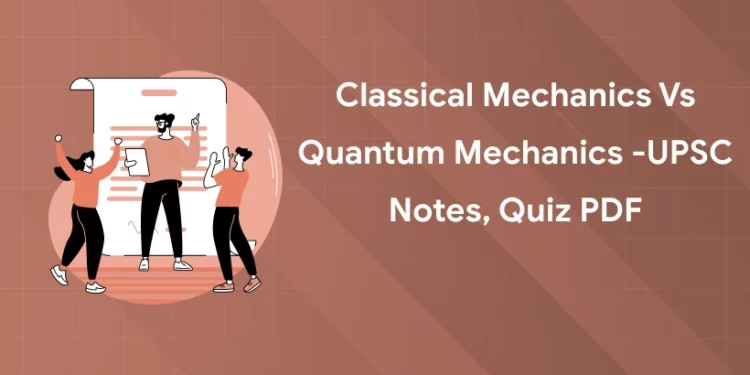In the realm of physics, the study of mechanics is foundational, yet it bifurcates into two distinct domains: Classical Mechanics and Quantum Mechanics. For those preparing for the UPSC exams, understanding the fundamental differences and applications of these two branches is crucial. This blog aims to elucidate the key contrasts between Classical and Quantum Mechanics, providing insights relevant for your UPSC notes.
1. Fundamental Concepts
Classical Mechanics:
- Definition: Classical Mechanics deals with the motion of bodies under the influence of forces. It primarily follows Newton’s laws of motion.
- Key Principles:
- Newton’s Laws: The foundational laws describing how objects move in response to forces.
- Determinism: Given initial conditions, future states of a system can be precisely predicted.
- Continuity: Physical quantities like position and velocity are continuous and can be measured to an arbitrarily fine degree.
Quantum Mechanics:
- Definition: Quantum Mechanics explores the behavior of particles at atomic and subatomic scales, where classical mechanics fails to apply.
- Key Principles:
- Wave-Particle Duality: Particles exhibit both wave-like and particle-like properties.
- Uncertainty Principle: Proposed by Heisenberg, it asserts that certain pairs of physical properties, like position and momentum, cannot be simultaneously measured with arbitrary precision.
- Quantization: Physical quantities such as energy are quantized, meaning they take on discrete values rather than continuous ranges.
2. Scope and Applicability
Classical Mechanics:
- Applicability: Excellent for macroscopic phenomena. It applies to everyday objects and systems where quantum effects are negligible.
- Limitations: Fails at very high velocities (close to the speed of light) and at atomic scales. For example, it cannot accurately describe electron behavior in atoms.
Quantum Mechanics:
- Applicability: Essential for understanding atomic, molecular, and solid-state physics. It describes phenomena like the behavior of electrons in an atom, superconductivity, and quantum computing.
- Limitations: While it offers an accurate description of microscopic systems, it can be less intuitive due to its abstract nature.
3. Mathematical Framework
Classical Mechanics:
- Equations: Governed by differential equations such as Newton’s second law F=maF = ma and Hamiltonian mechanics.
- Mathematical Tools: Calculus, vector algebra, and classical differential equations.
Quantum Mechanics:
- Equations: Described by Schrödinger’s equation for non-relativistic particles and Dirac’s equation for relativistic cases.
- Mathematical Tools: Linear algebra, complex numbers, and probability theory.
4. Experimental Validation
Classical Mechanics:
- Experiments: Extensive validation through experiments involving projectiles, pendulums, and planetary motion.
- Accuracy: Highly accurate for macroscopic phenomena, as evidenced by successful predictions and engineering applications.
Quantum Mechanics:
- Experiments: Confirmed by experiments such as the double-slit experiment, photoelectric effect, and particle accelerators.
- Accuracy: Extremely precise for microscopic systems, leading to technologies like lasers and MRI machines.
5. Philosophical Implications
Classical Mechanics:
- View of Reality: Offers a deterministic view of the universe, where the future is a predictable outcome of the present state.
- Human Perspective: Intuitive and aligns with everyday experiences of motion and force.
Quantum Mechanics:
- View of Reality: Introduces probabilistic and non-deterministic elements. The observer effect and the concept of superposition challenge classical notions of reality.
- Human Perspective: Often perceived as counterintuitive, leading to debates about the nature of reality and observation.
6. Practical Implications
Classical Mechanics:
- Applications: Engineering, aerospace, automotive industries, and everyday technologies.
- Tools: Used to design and understand the mechanics of machinery, vehicles, and structures.
Quantum Mechanics:
- Applications: Essential for modern technologies such as semiconductors, quantum computing, and nanotechnology.
- Tools: Drives advancements in materials science, medicine, and information technology.
Prepare for Competitive Exams! Download Entri App
Classical Mechanics vs Quantum Mechanics Quiz for UPSC Preparation
Quiz PDF for UPSC Preparation
To reinforce your understanding, a well-structured quiz can be immensely helpful. Below is a sample set of questions that you can include in your quiz PDF for revision:
Here are some multiple-choice questions (MCQs) comparing and contrasting classical mechanics with quantum mechanics:
1. What is the fundamental difference between classical mechanics and quantum mechanics?
- A) Classical mechanics uses wave functions; quantum mechanics uses particles.
- B) Classical mechanics deals with macroscopic systems; quantum mechanics deals with microscopic systems.
- C) Classical mechanics uses probabilities; quantum mechanics uses deterministic equations.
- D) Classical mechanics incorporates wave-particle duality; quantum mechanics does not.
Answer: B) Classical mechanics deals with macroscopic systems; quantum mechanics deals with microscopic systems.
2. Which principle is central to quantum mechanics but has no counterpart in classical mechanics?
- A) Newton’s laws of motion
- B) The principle of superposition
- C) The conservation of energy
- D) The principle of least action
Answer: B) The principle of superposition
3. In classical mechanics, the position and momentum of a particle can be known precisely. What is the analogous concept in quantum mechanics?
- A) The uncertainty principle
- B) The Schrödinger equation
- C) The Hamiltonian operator
- D) The principle of relativity
Answer: A) The uncertainty principle
4. Which of the following is a classical concept but is not directly applicable in quantum mechanics?
- A) Conservation of momentum
- B) Trajectories of particles
- C) Newton’s second law of motion
- D) Kinetic energy
Answer: B) Trajectories of particles
5. In quantum mechanics, the energy levels of an electron in an atom are quantized. What does this mean?
- A) Electrons can have any energy value.
- B) Energy levels are continuous.
- C) Electrons can only occupy specific discrete energy levels.
- D) Energy levels are probabilistic.
Answer: C) Electrons can only occupy specific discrete energy levels.
6. Which of the following describes a quantum system’s wave function?
- A) It represents the definite position of a particle.
- B) It provides the probability distribution of a particle’s position and momentum.
- C) It is analogous to a classical trajectory.
- D) It describes the exact path of a particle.
Answer: B) It provides the probability distribution of a particle’s position and momentum.
7. What phenomenon in quantum mechanics shows that particles can exhibit both wave-like and particle-like properties?
- A) Quantum entanglement
- B) Quantum tunnelling
- C) Wave-particle duality
- D) The photoelectric effect
Answer: C) Wave-particle duality
8. Which mathematical tool is commonly used in quantum mechanics but not in classical mechanics?
- A) Differential equations
- B) Matrices and operators
- C) Vectors
- D) Scalars
Answer: B) Matrices and operators
9. What is Heisenberg’s uncertainty principle primarily concerned with?
- A) The speed of light in a vacuum
- B) The relationship between energy and mass
- C) The limits of precision in measuring certain pairs of physical properties
- D) The invariance of physical laws under transformations
Answer: C) The limits of precision in measuring certain pairs of physical properties
Prepare for Competitive Exams! Download Entri App











